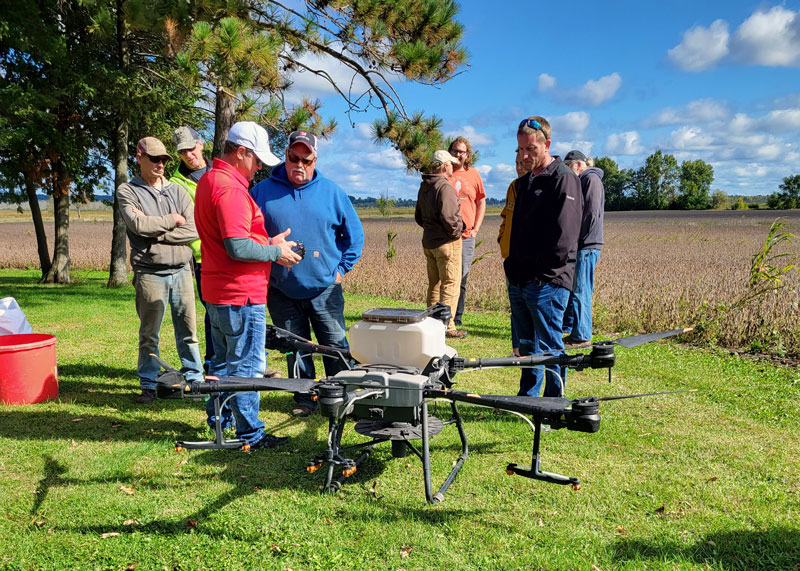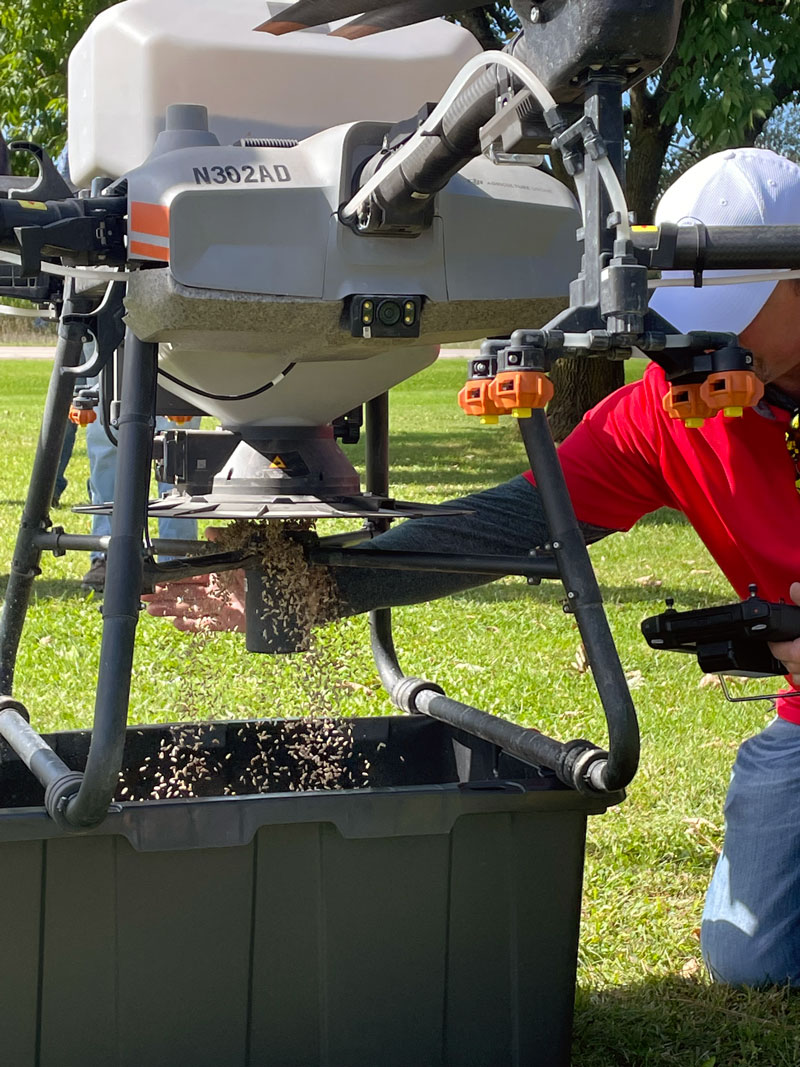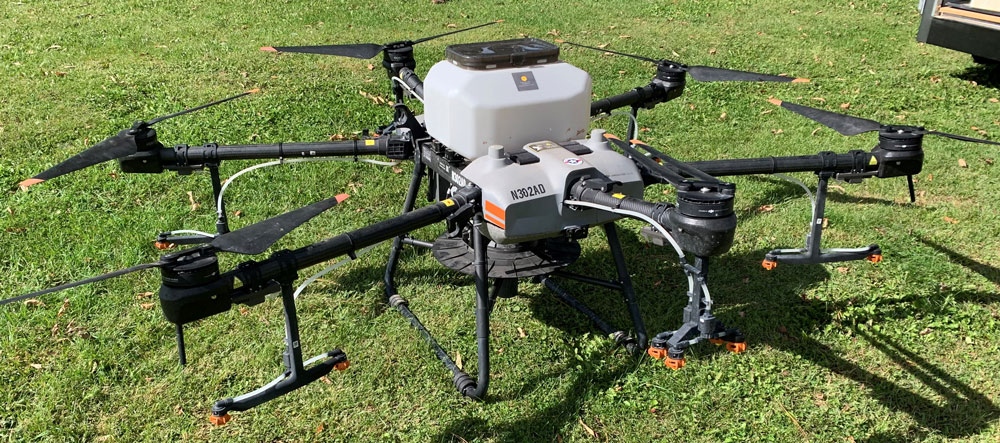By Justin Loehrke, Basin Ag Coordinator, Fox-Wolf Watershed Alliance; justin@fwwa.org
This fall, you may have noticed more interest in the use of drones in agriculture. To learn more, I talked with Jeremy Williams from American Drone and a couple of our local farmer champions to get their perspective on the use of this technology.
I first met Jeremy at a Winnebago County Land Conservation Department’s field day near the Rat River at Dan Rieckmann’s farm this past September. Dan is one of our Fox-Wolf Farmer Champions trying out cover crops. Jeremy was using a DJI T-30 drone to spread a rye and rape cover crop seed mixture into standing corn and soybeans at a rate of 36 lbs/acre. Jeremy’s big personality and engaging demeanor had the farmers asking great questions and learning a lot about the new technology. A few months later, I had the opportunity to dig in and learn a little more.
What’s changed?
Jeremy pointed out that until recently, the battery life and weight capacity of the drones made it challenging to use drones for agriculture purposes. “There was interest early, but it was tough to make the math work from a business standpoint,” he said. “Thankfully, the technology is evolving rapidly. Once the payload reached 30 liters (about 8 gallons) for liquid, we could make a business out of it”.
In the 8 months since Jeremy purchased his largest drone built by DJI, the manufacturer had already released a bigger drone that could carry about 20% more, and an even bigger one was on its way. Jeremy noted that as drones continue to get bigger, “they become even more efficient and cost effective for spreading cover crop seed and applying pesticides, herbicides, or fungicides”.
The ‘sweet spot’ for drone use
Jeremy reported that 15 to 20 pounds per acre is the current seeding rate that hits the sweet spot. With aerial application, it is best to use species that tend to do better in a broadcast application and have a lower pound per acre seeding rate. “I’m getting pictures from a lot of farmers with nice green fields so preliminary results are positive,” he noted. “If we are getting moisture, they seem to do well”.
Wet fall weather and late harvests were a couple of reasons highlighted by the Fox-Wolf Farmer Champions that tried drone applications this year. Dan Rieckmann noted he liked having different options available to get cover crops planted before harvest.
At $20/acre to seed plus the cost of your seed, I think the price is in line with other options,” Dan said. “The biggest thing I like about a drone application is I don’t have the field traffic in my growing crop. If we have a wet fall, I can still get my cover crop seeded, but I also don’t have to worry about damage to the cash crop or the field with a drone. I see enough in this tool I am even considering getting licensed to fly”. Dan hired American Drones to aerial seed just over 100 acres of cover crops with a DJI-T30 Drone at a rate of 36 lbs/acre this past September.
Photos from the field day hosted by Dan Rieckmann’s , one of our Fox-Wolf Farmer Champions in the Rat River Watershed, this past September.

Jeremy demonstrating how the controls for the drone work.

Jeremy demonstrating how the drone drops and spreads seed.

Jeremy loading cover crop seed into the drone.
Another application
Matt Kesler from Kesler Farms echoed some of the same sentiment, minus the desire to get licensed. Matt was looking for a way for his cover crop after soybeans to produce a nitrogen credit for his following corn crop. Waiting until after harvest to plant just about eliminated many of his options.
Matt hired Agri-Drone to spread a cover crop mixture that was heavy in legumes into his standing beans to see how it would work. Matt noted, “There is a little more risk as I am using a little more expensive seed with a legume heavy mix, but getting additional time in the fall for growth is key in generating a higher nitrogen credit”.
When asked about other applications he might try, Matt mentioned interseeding his grain corn, “I wouldn’t mind eliminating the wear and tear on my equipment planting into the corn stubble by having the cover crop planted before harvest”. Matt also indicated that he might consider planting clover into his wheat, “I probably wouldn’t do in the spring, but I could see using a drone to spread a few weeks before harvest to give the clover a head start. Spring time would likely get me a higher nitrogen credit if successful, but it would also limit my herbicide options should an application be needed in the field. I am not sure I want to risk it yet”.
Looking to the future: Don’t count drones out
Jeremy from American Drone noted his biggest limiting factor is new pilots. Pilots need to be licensed by the Federal Aviation Administration (FAA) to fly drones and they need a state applicators license to spray. To address the bottleneck, Jeremy worked with Fox Valley Technical College to help create a class where students completing the course could leave with both. Both Fox-Wolf Farmer Champions agree that drones are a useful tool in agriculture and that they’re here to stay. And if Dan’s continued curiosity becomes reality, we just might have a Farmer Champion taking to the sky.
Questions? Contact us:
Climate Smart Agriculture Project Manager: Katie Woodrow, 920.915.5767 or katie@fwwa.org
To receive periodic updates on these projects as well as many others, please subscribe to our newsletters: CLICK HERE
Winnebago Waterways is a Fox-Wolf Watershed Alliance recovery initiative. Contact us at wwinfo@fwwa.org









